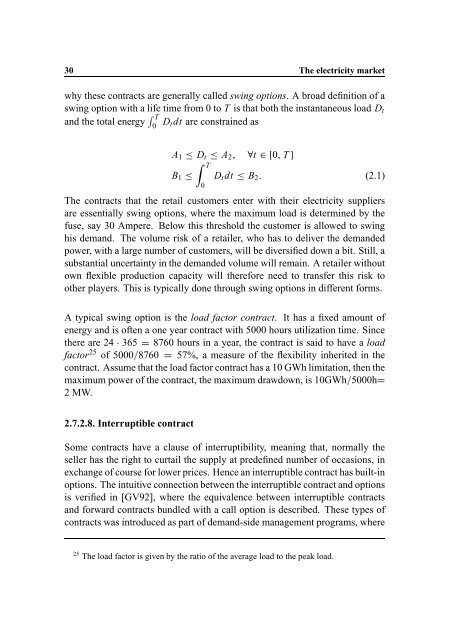Hedging Strategy and Electricity Contract Engineering - IFOR
Hedging Strategy and Electricity Contract Engineering - IFOR
Hedging Strategy and Electricity Contract Engineering - IFOR
You also want an ePaper? Increase the reach of your titles
YUMPU automatically turns print PDFs into web optimized ePapers that Google loves.
30 The electricity market<br />
why these contracts are generally called swing options. A broad definition of a<br />
swing option with a life time from 0 to T is that both the instantaneous load D t<br />
<strong>and</strong> the total energy<br />
T<br />
0 D tdt are constrained as<br />
A 1 D t A 2 t 0 T<br />
B 1<br />
0<br />
T<br />
D t dt B 2 (2.1)<br />
The contracts that the retail customers enter with their electricity suppliers<br />
are essentially swing options, where the maximum load is determined by the<br />
fuse, say 30 Ampere. Below this threshold the customer is allowed to swing<br />
his dem<strong>and</strong>. The volume risk of a retailer, who has to deliver the dem<strong>and</strong>ed<br />
power, with a large number of customers, will be diversified down a bit. Still, a<br />
substantial uncertainty in the dem<strong>and</strong>ed volume will remain. A retailer without<br />
own flexible production capacity will therefore need to transfer this risk to<br />
other players. This is typically done through swing options in different forms.<br />
A typical swing option is the load factor contract. It has a fixed amount of<br />
energy <strong>and</strong> is often a one year contract with 5000 hours utilization time. Since<br />
there are 24 365 8760 hours in a year, the contract is said to have a load<br />
factor 25 50006 of 8760 57%, a measure of the flexibility inherited in the<br />
contract. Assume that the load factor contract has a 10 GWh limitation, then the<br />
maximum power of the contract, the maximum drawdown, 10GWh6 is 5000h<br />
2 MW.<br />
2.7.2.8. Interruptible contract<br />
Some contracts have a clause of interruptibility, meaning that, normally the<br />
seller has the right to curtail the supply at predefined number of occasions, in<br />
exchange of course for lower prices. Hence an interruptible contract has built-in<br />
options. The intuitive connection between the interruptible contract <strong>and</strong> options<br />
is verified in [GV92], where the equivalence between interruptible contracts<br />
<strong>and</strong> forward contracts bundled with a call option is described. These types of<br />
contracts was introduced as part of dem<strong>and</strong>-side management programs, where<br />
25 The load factor is given by the ratio of the average load to the peak load.
















